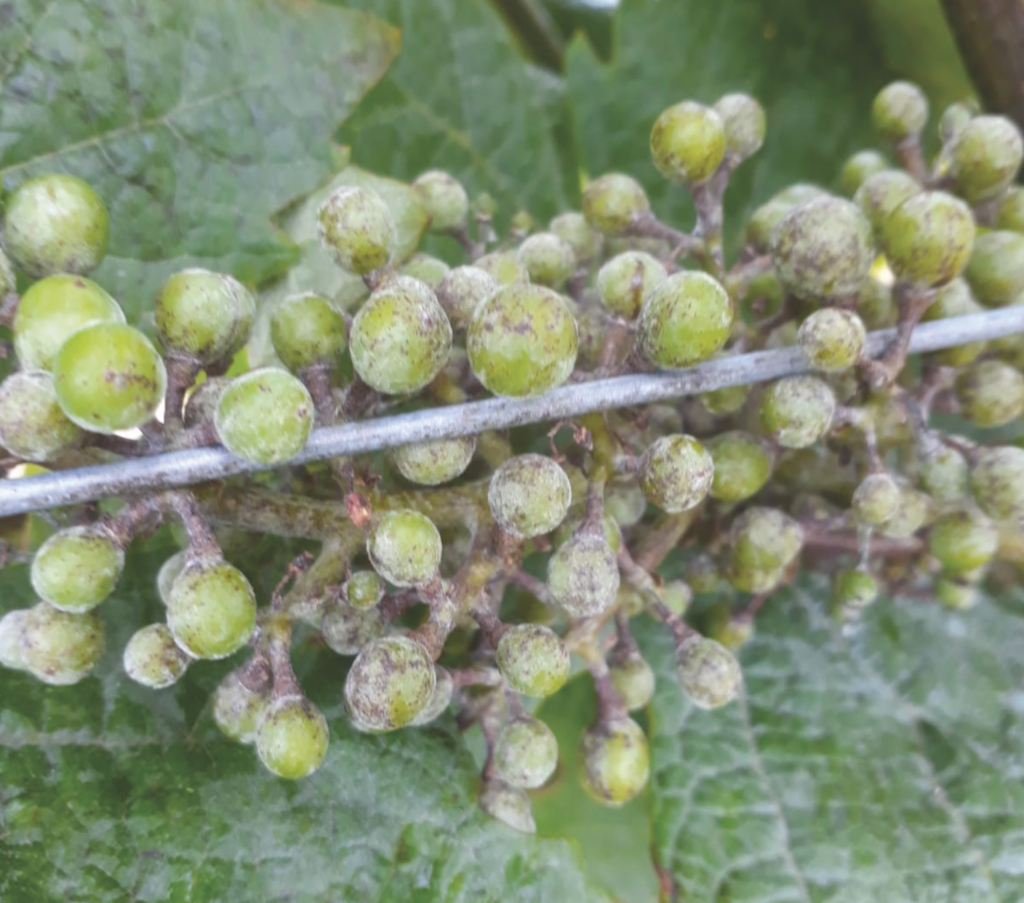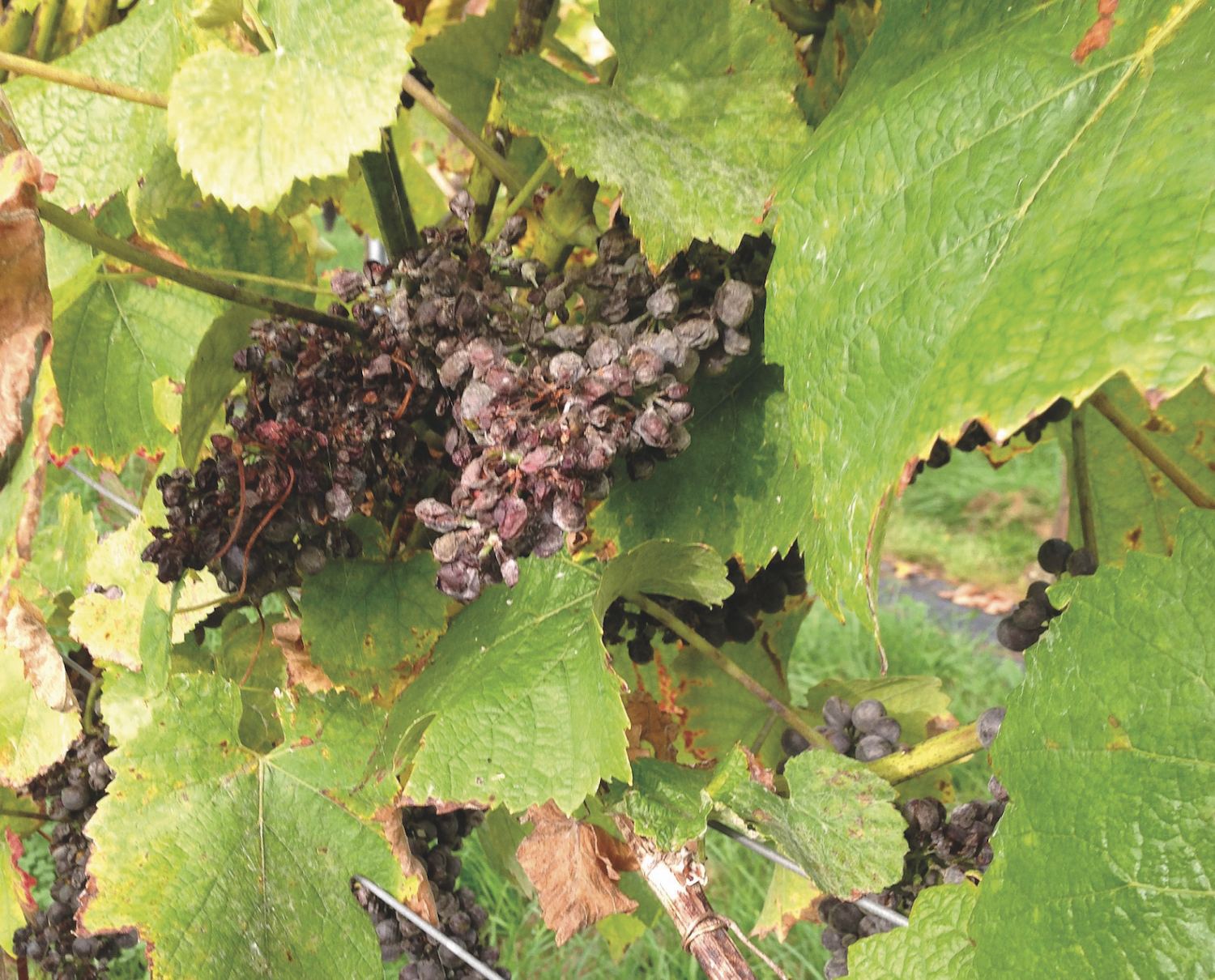Late season threat to grape harvest
26th October 2023
2023 brought a dull July with low light levels, high rainfall and low temperatures, so this year’s grape harvest will almost certainly be a low-sugar and late one. This will increase the risk of fungal diseases such as downy mildew and grey mould, which can be difficult to manage. Two of Hutchinsons’ senior agronomists, viticulture lead Chris Cooper and horticultural agronomist Rob Saunders, review the options open to growers to manage these challenging pathogens.

Downy mildew
This season, veraison has been late, protracted and incomplete on many sites, raising the prospect of a late harvest, says Robert.
“Our task is to turn sunlight into wine. Growers will be familiar with the slowing of sugar production as October approaches, the days get shorter, and the sun loses its intensity.
Adding to the challenge, the warm spell at the start of September resulted in acidity levels dropping, in the early varieties at least, so monitoring the crop to track the development
of quality parameters will be more important than ever.
“Some growers had already green harvested so the remaining berries have more assimilates routed to them and an improved chance of ripening.
“One of the toughest decisions the grape grower has to make is when to start the harvest and how to minimise the incidence of the major pathogens that threaten the harvest, particularly as plant protection product harvest intervals
have to be respected.”
Botrytis significant
Chris notes: “Botrytis is particularly significant for this year’s crop because of the wet September, late harvests which are likely to be going on in October and early November, and latent infection in the late flowering varieties due to rain during the critical flowering period.
“This year crop set was very good, but the August weather made it difficult to keep downy mildew at bay, so it is now affecting many sites.”
One of the challenges that growers face is that all the traditional fungicides that tackle downy mildew and botrytis have a harvest interval of 21–35 days and a limited number of applications, which makes combatting these pathogens complicated.
There are cultural management options available to help control downy mildew in established vineyards; good canopy management helps increase air movement and exposing bunches optimises spray penetration and coverage whilst giving the bunches exposure to sunshine and UV light so that they dry sooner, decreasing the incidence of the disease.
However, this method also means that some of the crop may be lost due to sunburn, affecting yield, says Chris.
Overall, reflects Rob, there is a lack of effective control due to the harvest interval requirements with traditional chemistry requiring growers to move to biocontrols and nutrition to bolster plant health. The results are variable but improving as growers get used to these products and manufacturers continue their development.
“Fortunately, there are some feeds which help the plants deal with stress, such as Procrop ISR, which comprises a yeast extract that the plant interprets as disease, stimulating its immune response,” continues Rob.
Finally, he recommends growers do not neglect post-harvest feeds especially products containing copper, zinc and sulphur.

The impact of a significant downy mildew infection.
Hygiene and targeting overwintering spores
As the vines senesce, downy mildew spores from fallen leaves, fruit and other infected plant material, overwinter in the soil and litter layer beneath vines.
There are two types of downy mildew spore; conidiospores which are asexual produced in the spring/summer in large quantities on infected green tissue, and ascospores which are the sexual phase produced in lesser numbers in the late summer early autumn and are encased in the nearly indestructible cleistothecium. The cleistothecium can survive a great deal of physiological damage, making control extremely difficult, explains Chris.
“In a good year, the risk of infection is limited, but this year the dull, warm damp weather has increased the risk, with the potential legacy spores remaining for a long time.”
The problem is that spores overwinter on green tissues, and although strict vineyard
hygiene, such as removing plant material via sweeping, pulverising and/or burning will help to reduce spore loading going into winter, when the harvests are late or autumn is very wet, it leaves the ground wet and muddy so there is a limit as to how effective it can be.
“Despite growers deploying all these cultural measures, inoculum will remain in and around the vines from spores that have fallen onto the soil surface, so, if possible, growers are encouraged to use a mulch or spray with urea and molasses to enhance general microbial activity, as this can still have a beneficial effect.”
Reducing future infection rates
Chris explains that the objective is to enhance soil biota which has a chance of reducing the downy mildew inoculum by consuming or destroying the spores, suppressing pathogen survival rates and reducing future infection rates.
Looking to the future, he reflects that some growers already have access to predictive models such as that in Metos which predicts the risk of powdery mildew, downy mildew and black rot, so they can take appropriate measures.
“Using decision support tools to predict the risk of infection is an important way forward, and work is progressing for our integrated management tool Omnia to be used as a predictive tool to give more timely and early interventions if required.”
Rob continues: “As the plant protection toolbox becomes more limited, it is increasingly important that we not only investigate how biocontrol options can be better integrated into future disease control programmes, but also explore
the potential of disease-resistant vines.
“At present, all the traditional cultivars are susceptible to powdery mildew and downy mildew, and there are no varieties with good resistance to botrytis.
“Nonetheless, breeding new varieties with the most durable and broad resistance to fungal diseases is possible, and resistant varieties, known as PiWis – which generally carry resistance genes to some pathogens which, we hope, are unlikely to break down – are already available to grow.
“This is a developing area for the future and will require both winemakers and consumers to accept new varieties.”
Downy mildew (Plasmopara viticola) is a serious disease because it can cause defoliation of vines, affecting grape quality and taste, and can cause total crop loss. One of the problems for growers is that there is very limited chemistry to control the issue, no commercially grown cultivars are resistant to infection. It requires rainfall for the initiation of the epidemic plus subsequent episodes of leaf wetness humidity for secondary infections to take hold.
Controlling the pathogen is not a problem in dry conditions, so the best control is dry and hot weather. One of the problems growers face is that there is very limited chemistry to control the issue and no commercially grown cultivars are resistant to infection. Some PiWis show a good tolerance and a few are said to be resistant but are not yet under commercial production in quantity in the UK.
Grey mould (Botrytis cinerea) infections often originate during flowering, after which infections remain latent, only becoming apparent as the sugar levels rise and the skins become thinner.
Tightly-bunched varieties are also particularly problematic, but for a different reason; as the bunch expands, berries in the centre rupture due to turgor pressure, and the free juice liberated is rapidly colonised by botrytis, which eventually affect the whole bunch, and then possibly the adjacent bunches as well.
